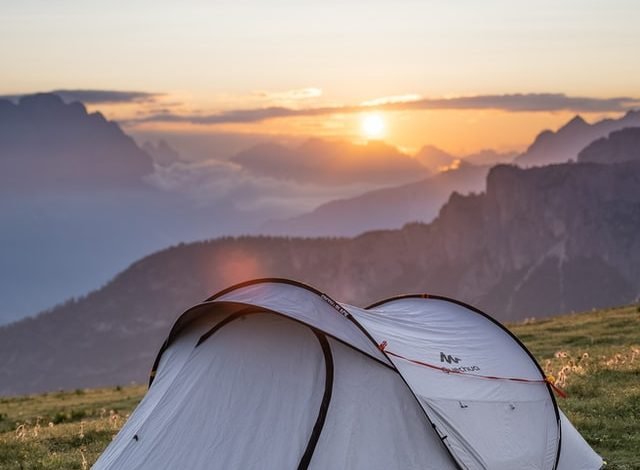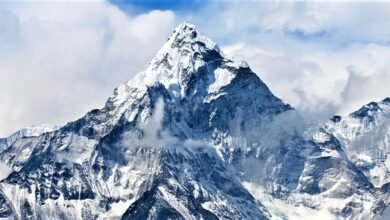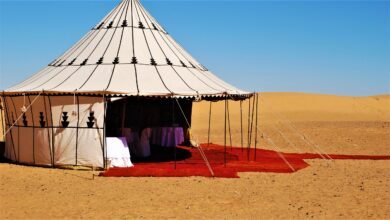Every tip, trick and hack you need to know

Every tip, trick and hack you need to know
If you’re not prepared for it, rain can ruin an absolutely amazing camping trip. Wet equipment, water in your tent, fires that won’t light up and more will leave you feeling cold to go home and never come back.
On the flip side, if you’re properly prepared, camping in the rain can range from mildly interrupted to really fun, and even a welcome challenge.
index:
Use this index to go directly to the section of this post you’re interested in reading more about.
Choose the correct tent site and camping site
Choosing the right camp site and tent is one of the most important steps to ensuring that you have a dry, warm, and fun rain camping experience.
What you want to look for is an area with higher ground and ideally trees above it (which you will later attach to the fabrics). You want to avoid low-lying areas where runoff water may collect and become saturated with heavy rain. You don’t necessarily need the highest point possible, but be sure to avoid the lowest point.
Trees and a brush that you can use to hang the fabrics will also be very convenient.
Valleys are usually the wettest and coldest areas. If you must set up camp at the bottom of a river or canyon valley, be sure to set up above the high water mark to stay dry and safe in the event of a flash flood.
Find this post useful? Pin it for later!
Create a rain-free outdoor space by using fabrics and paracord
Camping covers are incredibly useful for almost any camping adventure, especially when camping in the rain. A lightweight piece of fabric will allow you to create an overhead shelter for relaxing and waiting for the rain.
With a tarp, a roll of paracord, and a few trees, you can easily create a shelter to do cooking, play a game, take a nap, or just hang out with your friends and family.
Even if it doesn’t rain or rain is in the forecast, I often set up a tarp shelter for a shaded relaxation area and to protect my prepared kitchen in case the unexpected happens.
Other uses for your cannabis camp:
If I need to set up camp while it rains, I will not only make a tarp shelter to lie in, but I will make another shelter above where I set up my tent. This allows me to keep my tent dry and out of the rain while I’m setting it up.
Placing a tarp under your tent will provide a valuable layer of protection between the bottom of your tent and the ground, helping to prevent rips and prevent water from the ground from finding a way to reach your dry tent.
If I have enough tarps, I like to put one on the floor under a tarpaulin shelter. This prevents campers from having to ramble on wet and/or muddy ground and make a mess of everything during a rainstorm.
Wet Equipment Drying
Sometimes it rains and you can’t help but end up with wet clothes and gear. This is where you will need to dry-dry your equipment to return it to optimal performance.
The problem here is that there are so many variables that it may take some creativity when drying your gear.
If you have a tarpaulin and barcord and are able to set up a tarpaulin shelter, your obvious choice is to hook up a drying line and hang your clothes and gear to dry overnight. If you are able to start a fire nearby, the heat from the fire can help dry your equipment quickly (don’t get carried away!).
But what if you don’t have a tarp or a fire burning? Other options are not always pleasant.
On a few occasions, I’ve had to try hanging clothes inside my small one-person tent to dry while another idea (which I didn’t) is to put wet clothes inside your sleeping bag to dry from body heat. .
If you’re wearing good wicking clothing (which I talk about later), holding it will wick moisture away from your body through the clothing. This will actually dry them out faster than taking them off if you can’t put them on a good drying line near the fire.
Create fires in the rain
Creating a campfire efficiently is an art form in itself, making a campfire in the rain, with potentially wet fuel on it, is a really difficult task.
ignition
First, you have to make sure you always have the power to start a fire. Whether it’s a small stove, campfire, or something else, you need a reliable lighter when camping.
Serious fire start options, from least effective to most effective, include a magnesium fire starter, waterproof matches, and a waterproof spark plug. Water is the key here. Regular matches that get wet are useless. And just to be sure, don’t think for a second that you’re going to start a fire with sticks like the one you saw on Youtube, far from hard.
tinder
Next, you need your Tinder. Tinder is something lightweight, it catches fire incredibly easily and burns fast. In the event of humidity and rain, you still have a few options for using Tinder.
First, check under the pine trees for the quality of the adhesive. Pine trees usually have a thick layer of needles lodged under the tree, and if you dig down, you may be able to find dry needles under the first layer. The same might be true under any other type of tree or thick grass as well.
Another option is to make your own ignition material from fallen wood. Find the driest stump possible and start peeling off the bark. Under the carpentry you will find that the wood is dry. Take your survival knife (always pack a survival knife, right?!) and scrape it along the dry wood to form super-thin sawdust. These should light up easily and burn quickly and hot.
The last option is packing in a waterproof igniter. This is actually a smart thing that you should always pack in your emergency/survival kit. While there are plenty of options for Tinder on Amazon, a good option is UST WetFire Tinder. These are individually coated tablets that burn hot for 5 minutes and can burn in any weather, even when wet.
Beyond the Tent How to Create the Ultimate Camping Survival Kit
kindle
Kindling is a small fuel that lights up easily but burns longer than ignited. This usually includes small twigs, branches, and pinecones. The driest ignition is usually found under trees, thick grasses, and dense shrubs. If everything you find is wet again, try scraping the bark of young twigs to get to the dry wood.
You can also stack an additional flame to start drying under the tarpaulin.
firewood
Firewood is the largest fuel that will keep the fire burning for a long period of time. If you have already managed to turn on the wood and light a fire, you should have no problem lighting the firewood.
Before you start your fire, make sure you collect as much firewood as possible. Only use wood from fallen and already dead trees, because live wood will not burn and cutting down live trees is a bad thing.
Once you have collected the firewood, peel off the bark if necessary (keep this on for later ignition and refuel once it dries). Next, split the wood to reach the dry center. By splitting the wood it will burn easier and greatly increase the chances of a big fire. A high-quality camping hatchet is ideal for this job, although a survival knife can be used in an emergency.
Bored in the rain? Check out these 7 Rainy Day Camping Activities
Staying dry without shelter: tops / scallops
The biggest key to staying warm and comfortable when camping in the rain is staying dry in the first place. When you are at a camp site, this may mean staying under your shelter or in your tent. But more often than not, it rains when we least expect it, when we are not near our shelter or when we are old enough to not want to be stuck in our shelter.
This is when having the right upper classes is important.
There are many different options for the upper layers and it really depends on what kind of weather you’ll encounter. Extreme cold and heavy rain require very different equipment than a rain sprinkler or warm weather rain.
Your best bet for a top layer is to buy a jacket with a breathable waterproof membrane like Gore-Tex or eVent. REI has a great selection of these jackets that are durable, comfortable, waterproof and breathable.
If you are looking for something simple to have just in case of an emergency, a cheap rain suit or poncho and small packages is a great idea. Coleman sells a cheap PVC rain suit on Amazon that is easily worth investing in as an emergency rain suit. This jacket isn’t lightweight and isn’t something to be used for more than just an emergency.
Keep your equipment dry
Waterproof Backpacks, Daypacks & Transport Packages
So you’re out in the wilderness, it’s raining, you’re trying to stay dry and then you realize everything in your pack got wet because you picked a cheap backpack that was “waterproof” in theory, but the reality proved different.
Investing in a quality backpack for a specific type of trip is crucial. The high-quality packaging will carry all the gear you need, attach comfortably to your body, and are durable and not only waterproof, but weatherproof.
Boris makes hiking backpacks that I personally use and absolutely love. It is of high quality, durable and affordable. Obviously, REI has a lot of great high-end options for backpacks to choose from, too. These are ideal if you plan to utilize your pack a lot. If not, I have listed some great packages that are very cheap below.
The Cloudbreak 30L Backpack from FE Active is a great choice for a waterproof daypack. It’s 2.1 pounds, is water-resistant and can fit almost any budget.
The Master 50L Waterproof Outdoor Weekend Package includes a rain cover which is slightly larger than the 30L Cloudproof above. The perfect size for a 2-3 day trip.
If you already have a backpack and just need extra rain protection, a backpack rain cover is perfect. Use it with any backpack for extra protection when camping in the rain.
This Orange Sport rain cover is cheap and effective.
I’d kick myself if I didn’t mention my absolute favorites, the Granite Gear Portage Quetico 5000 and Superior One bundles. These packs are designed for transportation and are ideal for camping in the Boundary Waters Canoe area of Minnesota. I have both and they are incredible. It’s bulky, waterproof and incredibly comfortable. I actually use it for more than just portability.
Kayaking at BWCA with Granite Portage Packages
Kitico 5000 is a 5,000 cubic inch (82 L) canister. It’s sturdy and has plenty of room to store your tent, sleeping bag, food, and more.
The Superior One is a 7,400 cubic inch (121 L) package that can hold your tent, sleeping bag, food, cookware, tarps, and everything else you can imagine.
Waterproof Stuff Bags
Packing your non-waterproof gear properly is very important while camping and you may see some rain.
When I go camping where my pack can get wet, like a Bois Brule River cruise, I make sure everything is packed in bags of waterproof material inside my main pack. This allows my equipment to be protected with two different layers and has never let me down when I need to dry my gear when unpacking.
Staying Warm When Wet – Wear appropriate basic clothing and layers
So you manage to get wet and whether or not you have the ability to dry your gear, you need to stay warm. Getting wet and cold quickly can lead to hypothermia that can be life-threatening in the wild.
First aid essentials in the wild (including hypothermia)
What now?
This is where being prepared for a camping trip or layover can make or break, not to mention literally save your life. You need to make sure you pack the right clothes for the type of trip you are taking. If wetness is a possibility, if cold weather is forecast or even storms, bringing the right equipment is essential.
Cotton clothes
Cotton is good for a lot of things, it’s light and comfortable, but it’s the worst choice for wet and cold. Cotton has no wicking ability which means that once wet, it will stay damp and heavy and keep you cool. If you find yourself wet and cold while wearing cotton, you need to quickly remove the garment, dry it, and warm yourself up as quickly as possible. If you find yourself unable to dehydrate, you could be in big trouble.
wool clothes
Fleece is actually an almost perfect choice of clothing when camping outdoors. It’s waterproof, has great insulation and is great at wicking, which means that once wet, it will continue to keep you warm. With fleece, you can wear the clothes while they dry and keep yourself warm.
Wool feels snug because the fibers curl, which catches more dead air and therefore better insulates you from the elements.
The main problem with wool is that it is heavy, often itchy and uncomfortable.
wool
Fleece base layers are really great for most rain camping needs. It’s light, dry, has a good wicking, is soft, comfortable, and lasts for years. Wool can actually be very cheap and any serious camper will likely have a drawer full of different layers of wool.
The problems with wool is that it is not the warmest base layer in that it does not retain extreme heat when wet and the wind penetrates directly into it.
polypropylene
Polypropylene is probably the second best solution when it comes to clothes you want to wear if they get wet. Polypropylene is thin, lightweight, comfortable and absolutely great in wicking, allowing you to dry faster than cotton, wool and even wool.
You can find almost all major manufacturers making polypropylene clothing such as Patagonia, North Face and many other brands.
The real solution: merino wool
Merino wool has all the wonderful properties of wool, but it also fixes its problems. Merino wool has the ability to wick moisture away from your body toward the area that is least damp (the outside of the garment) and still feels dry while holding 30% of its weight in water, and most other fibers feel 7% wet. This means that you will be dry while wearing merino wool clothes and will feel dry, even when the clothes are wet.
Merino wool is very comfortable to wear. Traditional wool feels rough and itchy because of the large, hard fibers, Merino wool has smaller, softer fibers that feel comfortable (like cotton) against the body.
An added benefit of merino wool is that it naturally has anti-demand properties, keeping it smelling fresh even during a long walk.
About 4 years ago I got my first merino wool shirts from Ibex Clothing and I absolutely love them. My camping closet is now filled with various brands of merino wool clothing.
A few of my favorite merino wool makers:
- Ibex Apparel – Ibex offers everything you could need from base layers, top layers, hats, gloves and more.
- Minus 33 – another great company that offers everything you could want in merino wool.
- SmartWool– SmatWool offers great Merino wool clothing at really good prices.
Personally, I wouldn’t do any serious camping without packing a base layer of merino wool plus a few different pieces of merino wool clothing depending on the type of weather expected.
Camping Rain Essential Gear Checklist
- Waterproof rain jacket and pants
2. Waterproof boots and crocodile leg
3. Wicking base layer
4. 8 x 10 x plastic caps
5. 100 of Paracord
6. Extra tent stakes (to create a shelter)
7. Water matches
8. Water Tender
9. Survival Knife
10. Camping hatchet
11. Waterproof Backpack
12. Rain tarp backpack
13. Bags Dry Bags




One Comment